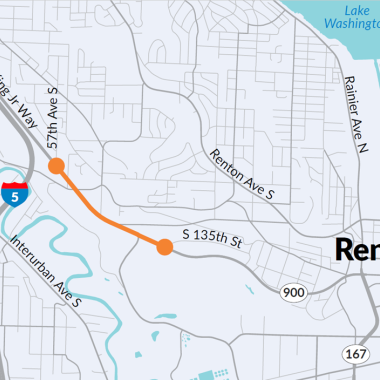SR 900 is a direct connection from Interstate 5 to the Skyway Community and the City of Renton. The SR 900 corridor has a posted speed of 45mph between I-5 and 60th Avenue South, 40mph between 60th Avenue South and 68th Avenue South, and 35mph between 68th Avenue South and Renton City Limits.
Average daily traffic on the corridor ranges from 25,500 vehicles east of South 129th Street to 13,000 vehicles west of South 135th Street. There are signalized intersections on this section of SR 900 at South 129th Street and 68th Avenue South. SR 900 is also a busy transit corridor served by King County Metro transit routes 101 and 102. The two transit routes provide direct transit service between Renton and downtown Seattle, with bus stops at South 129th Street and between 68th Avenue South and South 135th Street. This stretch of SR 900 does not have separated facilities for those who walk or ride a bike and has few signalized crosswalks. Most of this part of SR 900 is bordered by residential neighborhoods and apartment complexes.
WSDOT is working to make the section of SR 900 from 57th Avenue South to South 135th Street meet the active transportation needs of the community. A corridor study was completed in June 2023 to review bicycle and pedestrian facilities, roadway safety, operational performance and environmental issues. Design efforts are focusing on refining bicycle and pedestrian facilities and amenities, plus complementary traffic calming strategies. Proposed improvements would need to meet or exceed WSDOT’s guidelines for the level of traffic stress for pedestrians and bicyclists and address any route directness issues by reviewing the quality and frequency of roadway crossings, all within the context of community needs. This project is funded through design and temporary construction easements; further funding is needed for construction.
Healthy Environment for All (HEAL) Act
This project is also subject to Washington's environmental justice law, known as the Healthy Environment for All (HEAL) Act. Environmental justice in Washington State, as provided in the HEAL Act, addresses disproportionate environmental and health impacts in all laws, rules, and policies by prioritizing vulnerable populations and overburdened communities, the equitable distribution of resources and benefits, and eliminating harm (RCW 70A.02.010).
Environmental justice assessment
An Environmental Justice Assessment (EJA) will be completed for the project. These assessments are conducted for Significant Agency Action s (SAAs) that could harm the environment or impact how environmental benefits are distributed to overburdened communities (OBCs) or vulnerable populations (VPs). SAAs are actions initiated after July 1, 2023, and consist of WSDOT transportation projects and grants of $15 million or more, new grant or loan programs, agency request legislation and rulemaking. An EJA guides decision-making to ensure fair distribution of environmental benefits, reduce environmental harms, and address disparities in both environmental and health outcomes. Meaningful engagement with affected communities is a crucial aspect of this process.
Community engagement
Community engagement is planned during the pre-design and design phases. More information will be shared as it becomes available.
Working Groups
Technical Working Group (TWG)
The TWG consists of public works, engineering, and planning staff from local, regional, state and tribal entities. The TWG serves in an advisory role to WSDOT providing technical feedback at multiple steps in the pre-design process.
Technical Working Group Meeting 1
Wednesday, January 8, 2025
Presentation (PDF 3.7MB)
Summary (PDF 175KB)
Technical Working Group Meeting 2
Thursday, May 8, 2025
Presentation (PDF 5.3MB)
Complete streets
As with all state highways, any improvements to SR 900 would be subject to WSDOT’s Complete Streets design process. The Complete Streets legislation was passed in 2022, in Washington Senate Bill 5974. Complete Streets is an approach to planning, designing, building, operating, and maintaining the transportation system that enables safe and convenient access to destinations for all people, including pedestrians, bicyclists, motorists and transit riders. From a design perspective, Complete Streets focuses on the experience of the roadway's most vulnerable users, prioritizing accessible, low-stress environments for active transportation. The state will rely on community feedback to develop design alternatives in keeping with local active transportation goals.
Using the WSDOT’s Complete Streets approach, this project will go through a Complete Streets Pre-design phase to determine the cross-section and intersection controls for SR 900 from 57th Avenue South to South 135th Street. The pre-design phase of the project will include significant community engagement to understand the needs of tribes, overburdened communities, multimodal users, residents, and other interested parties in the area. The public and interested parties will have opportunities to give input on the design of SR 900 within the project limits.
Construction is not yet funded.
- Legislative Funding: $450,000
- Sandy Williams Connecting Communities Grant: $1 million
- Puget Sound Regional Council Transportation Alternatives Program: $3,157,250
Total: $4,607,250
There are currently no additional maps or drawings.

